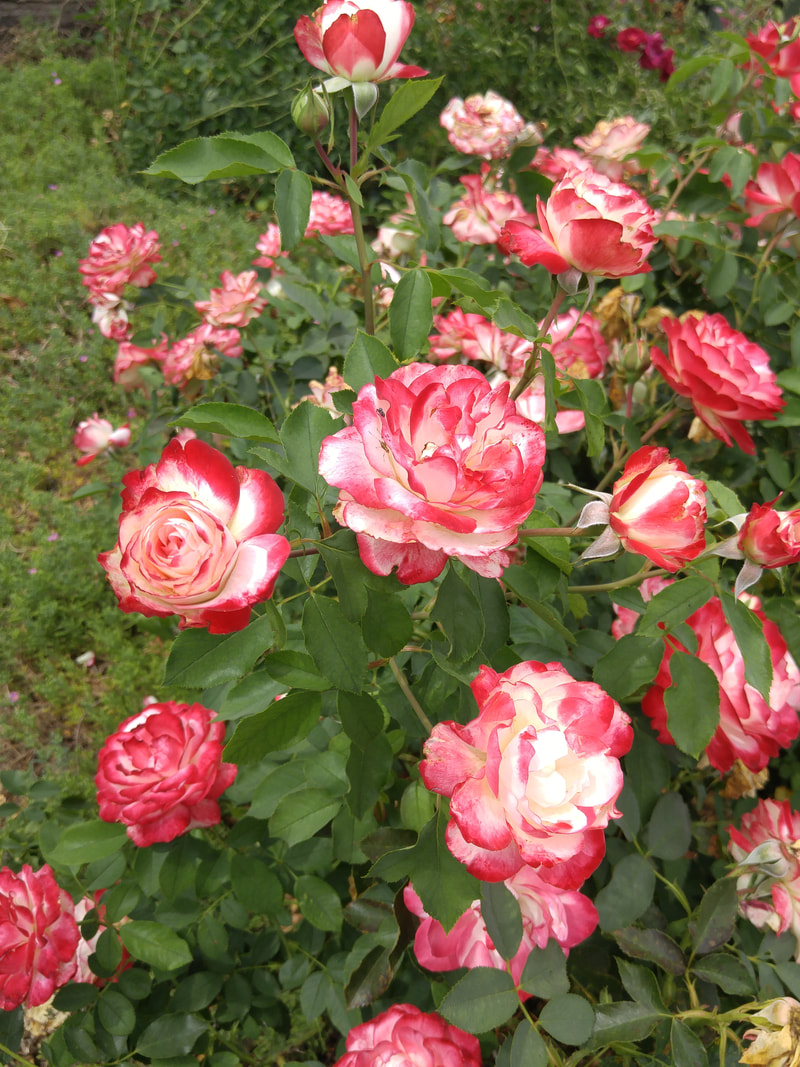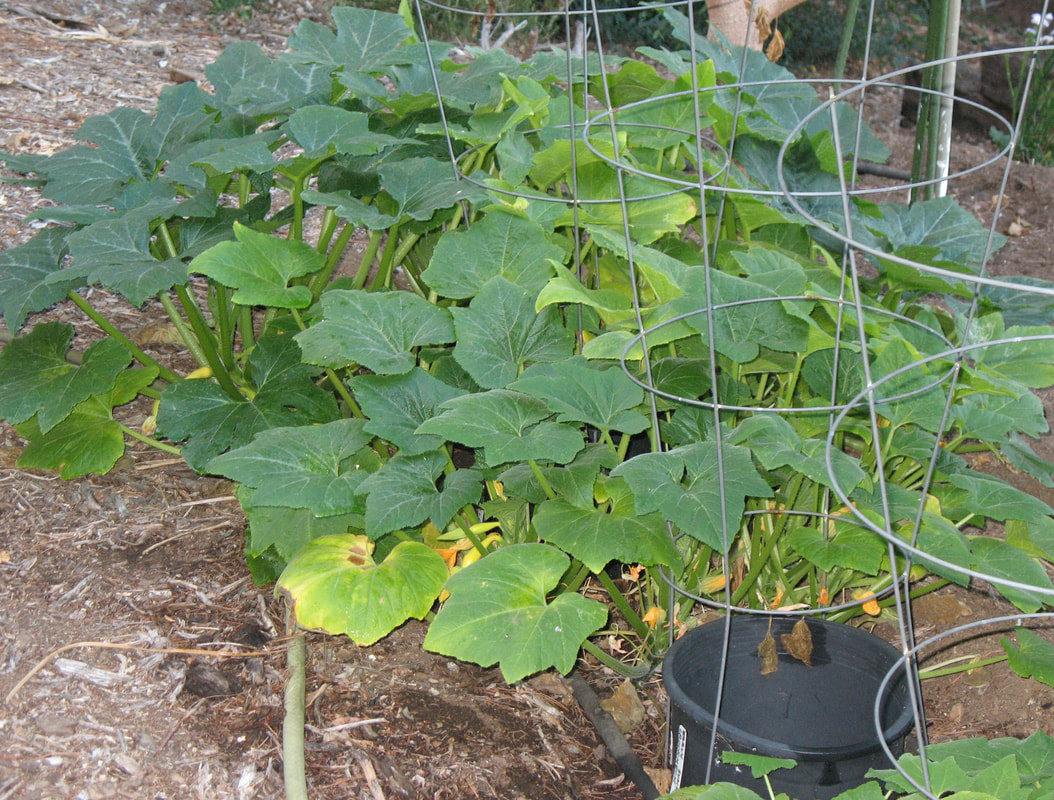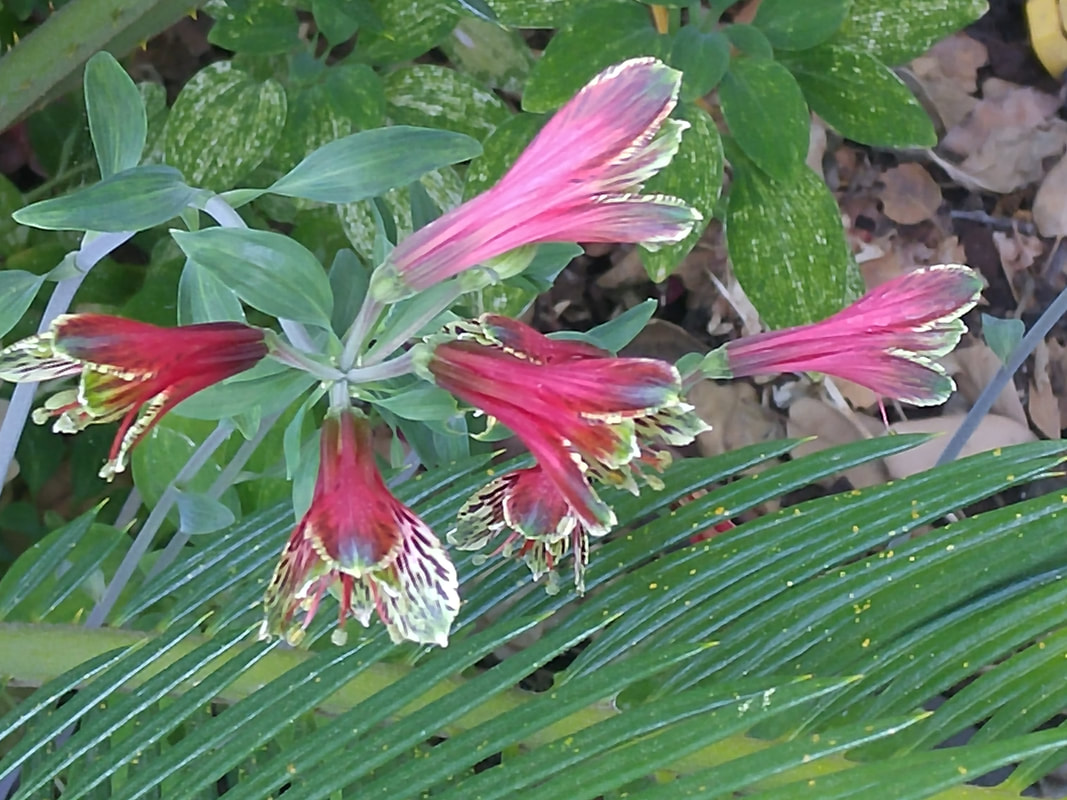| | "Oh, yuck! Those crummy bugs are all over my beautiful veggies, and do those poor plants look sick!" Has this wail and lament come to your garden yet? As long as there have been nasty critters and diseases that seem to appear spontaneously with a penchant for destroying vegetables that we've loved and labored over in our gardens, there have been solutions to be had. After the initial disgust, the first consideration should be to determine the acceptable level of infestation - just how much damage to your plants can you stand before you feel that you must take action? Just how many chewed or dried-up leaves can the plants stand, and how much yield can you sacrifice, before you are driven to counterattack? This level of tolerance is as personal as a taste preference. Some gardeners can't stand the sight of a single creepy-crawly beast or marred leaf or fruit, while other gardeners routinely plant extra to accommodate the anticipated loss. Generally, concerns for the health and safety of our food, the soil, and ground water supplies requires that we use the "small guns first." Start with the least disruptive action, such as blasting pests with jets of water from the hose. If the problem persists, apply increasingly destructive methods, such as narrow-spectrum pesticides for specific problems or pests. Take these intermediate steps, rather than turning immediately to the "one spray kills all" approach - because it does kill all, beneficial insects and soil organisms as well as the baddies. If the current generation of plants can't be saved, then certainly an improvement can be made for the next, whether in a subsequent planting or in next year's garden. Remember that all plants are determined to grow successfully to maturity - to produce foliage, flowers, fruits, and seeds - and then die. This is their natural process, and they will strive to proceed, no matter what. They will be more successful, and you will benefit more, when growing conditions - weather, fertilization, irrigation - are ideal. To what degree plants achieve this goal depends on the quantity and timing of these elements - whether provided by nature or by the gardener. How the conditions in your garden are altered for better or worse will affect whether your plants thrive, barely exist, or die. This, in turn, will determine their vulnerability to diseases and pests and the quality of the produce you harvest. In a word, healthy gardens make healthy plants, and healthy plants ward off diseases and pests more successfully than unhealthy ones. The most important means of combating pests and diseases is by good cultural practices. Thorough preparation of the soil before planting or sowing is necessary. Incorporating well-rotted manure, a balanced fertilizer, and compost will ensure that plants are given a good start in nutrition and proper drainage that will last through harvest. Additional compost or other organic mulches applied to the soil surface will help to retain soil moisture, provide further nutrients, and suppress weeds. Growing the same or closely-related plants in the same place year after year should be avoided, as this encourages a build-up of soil-borne pests and diseases, and it depletes the soil of the specific balance of nutrition that those plants need in common. Maintaining a clean garden means removing and destroying all infected plants and debris. Plants that have been badly attacked by pests or diseases should not be left in the garden to infect other plants or offer a steady diet for pests. Even relying on the heat of a properly constructed compost pile cannot completely dispose of the pests or diseases. Organic mulches must not include diseased material, particularly in the fall and winter, because they may overwinter to infect the next year's garden. Weeds should be kept under control before they set their new seeds since many are the hosts of pests and diseases, and they compete with cultivated plants for water and nutrients. BENEFICIAL INSECTS: THE GOOD GUYS Welcoming and providing for insect predators in your garden is a wise move. There are limitations to the value of purchasing adult predators, however. Once they've eaten their fill soon after release in your garden, they'll leave to find their meals elsewhere. Some adult populations - such as the ladybug - are "programmed" to automatically fly away from their point of release in order to search for their food. In both cases, they will no longer be around your garden to feed on subsequent populations of pests. In other words, you paid for them to eat but one meal from your garden. On the other hand, if you provide them with their preferred forage areas, release them in the early evening, and sprinkle the entire area so the plants are moist, the ladybugs may at least stay overnight and perhaps remain longer in your immediate area to benefit your during further pest scourges. Some of the predators more commonly used are: Predator (eater) Object (eatee) Aphytis wasp Scale Cryptolaemus Mealybugs Encarsia formosa Whiteflies Fly parasites Flies Lacewing Ants, aphids, some worms and caterpillars, and eggs and larvae of other pests. Ladybug Aphid, mite Praying mantis Wide variety (including their own mates!) Predatory mites Other mites Trichogramma wasp Variety of worms & caterpillars Another helpful predator is the daddy-long-legs, which constantly "combs" plants for aphids and larvae of other insects. PESTS: THE BAD GUYS Garden pests can be grouped into either of two major categories: chewers and suckers. The chewers bite to get what they want and include caterpillars, potato bugs, grasshoppers, and cutworms. Treat this group with filtered sprays of pungent concoctions made of ground-up parts of aromatic plants such as marigold, garlic, onion, or hot pepper. Many of these insects can be eradicated with two sprayings of a tabasco-detergent-alcohol spray. Combine one tablespoon liquid dishwashing detergent, one tablespoon of tabasco sauce, one quart of rubbing alcohol, and one gallon of water. Be careful to wear non-absorbent rubber gloves and to not breathe the fumes, as the tabasco liquid and vapor are very irritating. The second group suck plant parts. These include aphids, thrips, flies, and scale. Treat this group with sprays of a biodegradable insecticidal soap or oil solutions that asphyxiate the pests by coating them and clogging their respiration systems. Diatomaceous earth, when magnified, looks like a cluster of pins pointing out of a ball. These "pins" prick the bodies of insects, causing their body fluids to drain out. While fatal to most insects, it has no harmful effect on people or warm-blooded animals. Vegetables can be eaten the same day they're treated. However, be sure to use only the type sold specifically for the garden, not the one to be used in pool filters, which have their “pins” rounded off and so are ineffective treating insects. Aluminum garden siding or boards laid on the soil will attract a variety of pests to the cool darkness underneath them. Lift the boards in the early evening, destroy the pests, and replace the boards for the next day’s "catch." I’ve compiled this information from a variety of sources including the University of California Cooperative Extension, California Department of Agriculture, United States Department of Agriculture, Rodale Press, University of Wisconsin Cooperative Extension, and Washington State Cooperative Extension. Ants PROBLEM: Ants may be in general presence in the garden, but they are not automatically a problem since they do eat the larvae of fruit flies and houseflies, and caterpillars. They may also "herd" aphids for their honeydew, however, and then they do become a garden problem. SOLUTION: Paint tanglefoot on trunks of trees to keep ants and the aphids they "herd" away. A homemade sugar-and-yeast brew can be made very inexpensively. Stir together one pound of brown sugar and one-quarter teaspoon of baker's yeast into one gallon of warm water (80 degrees is ideal). If substituting refined white sugar, add a one-inch square of bread and one teaspoon of soil to initiate fermentation. For the greatest yeast activity and pest response, air temperatures should be between 50 to 100 degrees. Ants are attracted indoors by sweet or fatty foods, so keep these foods well-covered. Place cucumber peelings on cupboard shelves to deter them. Invasion paths into the house can be disrupted by sprinkling them with kitchen cleansing powder. Planting mint, pennyroyal, southernwood, and tansy by doorways will drive them away. Within a six-inch circumference of a nest entrance, stir in several tablespoons of Epsom salts into the top inch of soil. Use silica gel to seal openings around pipes and treat areas behind cabinets. Carpenter ants don't eat wood, but they do nest in it and can cause structural damage. They are fond of moist or partially-decayed wood. Firewood that is stored outdoors should be elevated above the soil level, provided with air circulation, and covered to keep it dry. Inspect the wood before bringing it into the house, and bring in only a small amount at a time. Aphids PROBLEM: If foliage is crumpled, curled, and yellow, and shiny and sticky with honeydew, or looks blackened with sooty mold, aphids are enjoying themselves. Aphids thrive on new, young growth and excessive nitrogen in the soil. SOLUTION: Add raw, carbon-rich organic matter such as straw or sawdust to the soil to put the excess nitrogen to work. Aphids are "herded" by ants, who "milk" them for their honeydew and can be blasted from their perches by a forceful stream of water from a hose. Spray them with a garlic/onion/paprika mixture or a biodegradable insecticidal soap and water solution. If the foliage looks dull and wilted after two days, rinse it off so that the plant can breathe again. Crush the aphids on branches, leaves, or flower buds - these "corpses" and "bug juice" warn off current and later generations. Dust the aphids with diatomaceous earth. Place aluminum foil or white plastic on the soil or mulch under the plant foliage to reflect sunlight - this disorients the aphids, and they'll settle elsewhere to feed. Sticky traps can be made easily from yellow plastic can lids. Paint the lids with a thin solution of honey or sugar and water, and set them outdoors near an infested area. When they have attracted and trapped many pests, wash the lids off, reapply the sweet solution, and set them in place again. Encourage ladybird beetles, lacewings, praying mantids, and syrphid flies. Aphids generally stay away from nasturtiums, spearmint, and stinging nettle. Earwigs PROBLEM: Earwigs are in the garden, eating decaying vegetation. SOLUTION: Most earwigs feed on other insects and are thus beneficial. When they become too numerous, however, they occasionally eat live plant parts. although their pincers look ferocious, they can't inflict real damage. Trap earwigs by placing rolled, moistened newspaper or cardboard near an infested area; check daily, and destroy earwigs. Earwigs also can be caught in a homemade sugar- and-yeast brew (see "Ants"). Flea Beetles PROBLEM: Many tiny holes in leaves, with more damage in the lower leaves, signal the presence of the flea beetle. SOLUTION: Spray with a garlic/onion infusion. For severe infestations, dust with wood ashes, diatomaceous earth, or rotenone. Rotenone also kills beneficial predators, so use it only for severe infestations. Flea beetle damage seldom occurs once the plants have developed beyond the seedling stage. Potatoes are safe to eat. Black flea beetles stay away from catnip, hyssop, mint, rosemary, sage, thyme, and wormwood. Interplant cole crops, lettuce, and tomatoes. Incorporate organic compost. In the fall, deter overwintering and laying of eggs by frequent cultivating of the garden and keeping it free of weeds and trash. Grasshoppers PROBLEM: If grasshoppers jump all around as you pass through the garden, they are probably chewing the foliage on your plants. SOLUTION: Catch and destroy them by stomping them. Protect seedlings by covering them with cheesecloth. In spring and early summer, the young are most vulnerable, and Nosema locustae may be the answer. It is a protozoan that attacks specifically grasshoppers and some species of crickets. Dissolve the spore in water, add it to a bran mixture (grasshoppers' favorite food), and then disperse this over the garden or yard area. As the grasshoppers feed on the Nosema-bran mixture, they become infected and slowly die. Surviving grasshoppers retain sufficient infection to reduce or inhibit reproduction. The infection is also transmitted when infected grasshoppers are eaten by healthy ones. In the fall, winter, and early spring, cultivate the soil and destroy cream-to-yellow colored egg clusters that look like grains of rice. Leafhoppers PROBLEM: If the tips and margins of leaves look dried or burnt, and white stippling is on the upper surfaces, the damage is probably due to leafhoppers. SOLUTION: Dust with diatomaceous earth. Employ lacewings. Plant petunias, geraniums as repellents. Remove and destroy affected plants. Keep the garden free of weeds. Leafminers PROBLEM: The leafminer leaves white blisters, tunnels, or blotches in plant foliage. SOLUTION: Handpick and destroy the infected leaves. Grow less-susceptible varieties. Keep garden free of weeds. Consider growing pak choi to replace infested spinach - the pak choi's taste and use in cooking is similar, its growth needs are the same, and it overwinters well. Loopers and Worms PROBLEM: The worm family which includes loopers and cabbage worms chews large ragged holes in the leaves they consume. Cabbage and lettuce heads may be bored into. The light green caterpillars and their droppings may be present. SOLUTION: Handpick and destroy the worm and its egg clusters, and destroy the adult white moths that flutter so prettily. Apply garlic/onion/paprika spray or dust with diatomaceous earth. Cover plants with cheesecloth when the adult white moths first appear, to prevent their laying eggs on plant foliage. For severe infestation, spray with Bacillus thuringiensis (Bt) or rotenone. Lacewing larvae and trichogramma wasps destroy the eggs that the adults lay. Mites, Spider PROBLEM: When foliage is stippled, loses color, wilts, and may be covered with fine webbing, mites have been at work. SOLUTION: Hose off the mites and their webs with a strong stream of water, including the undersides of the leaves. Sprinkle the plant foliage occasionally – both top sides and undersides - to keep it free of webbing. Lower surrounding air temperatures with applications of organic mulches. Spider mites thrive in hot, dry conditions and plants with a calcium deficiency. Maintain a more frequent watering schedule to eliminate the moisture-stress condition which initiated the calcium deprivation. Predatory mites and lacewings eat mites. Plant onions, garlic, and chives as repellents. Nematodes PROBLEM: The extended family of nematodes causes damage to plants that results in the foliage becoming yellowish and wilting readily on hot days, and roots that are stunted, knobby, and distorted with galls. Potato and sweet potato tubers have irregular dark brown sunken areas. SOLUTION: Plant resistant varieties. Incorporate organic matter. Rotate crops. Grow non-host plants for three or four years, and incorporate the plant matter into the soil before replanting host plants. Nematodes are susceptible to drying out, so turning the soil and allowing it to dry thoroughly can help reduce populations. Infested plant root systems should be carefully destroyed, not mulched or composted. Nematodes will not be a problem in biologically active soil, as the bacteria eat the nematode eggs. Nematode damage develops more frequently on stressed plants where the root systems are unable to take up adequate water and nutrients. Vegetables which are relatively resistant to root-knot nematode are asparagus, the cole crops, and sweet corn. Cherry tomatoes do not seem to be affected as severely as other tomatoes, and they will produce well, even in moderately-infested soil. Increasingly numerous nematode-resistant varieties of susceptible vegetables are available to choose from, especially of tomatoes. Plant red salvia, dahlia, calendula, and African and French marigolds as repellents. Slugs and Snails PROBLEM: Slugs and snails, which thrive in moist, cool conditions, give themselves away by their shiny, slimy, slick trails. They eat just about anything that's cool and succulent. SOLUTION: Eliminate harbors - boards, debris on soil and around the perimeter of the garden - or use these as attraction areas, and destroy those collected. Construct a yeast-and-sugar trap (see "Ants"), or use old beer. Snails love beer, even old flat beer, but they can't handle it. Any container with sides low enough for the snails to crawl into will do. The snails will plunge into the beer, absorb too much, and be unable to leave. Dispose of the dead snails, pour in more beer, and wait for another "catch." Paint tanglefoot on the trunks of trees to keep aphids and their ant "herders" off. Poison bait can be utilized in the garden so that it does not come in contact with it, and neither pets nor birds can get it - place some of the pellets in small baby food jars that are laid on their sides next to plants. The slugs can crawl in to dine and die, but the bait will remain dry even after overhead sprinkling. Barriers of sharp sand, powdered charcoal, diatomaceous earth, ashes, or sawdust will get caught in the mucous membranes of snails and slugs who try to cross. Reapply these after rain or overhead watering, as the particles are most effective when they remain dry and separate. Poultry-grade crushed oyster shells gives planting beds a dry, rough, sharp, alkaline surface which is avoided by slugs and snails. The shell powder is also good for raising the soil pH because of the high lime content. Fences can be constructed of 1/4" hardware cloth cut into strips and attached to wooden stakes or raised bed railings. Slugs and snails can't easily crawl up the mesh; but if they do manage, they can't crawl over the tiny spikes at the top without piercing themselves. Plant prostate rosemary, wormwood as repellents. Sowbugs and Pillbugs PROBLEM: Sowbugs and pillbugs are generally present in the garden, eating decayed vegetation. SOLUTION: Keep soil surface free of mulch for a two-inch area around plant stems. Provide good air circulation between plant foliage and the mulch underneath. Remove lower decayed plant leaves from the surface of the soil or mulch. Thrips PROBLEM: When dwarfed foliage wilts, is speckled, curled, crinkled and papery, silvery or tan colored, and dies, suspect thrips. Onions develop whitish chainlike marks on leaf surfaces and on distorted bulbs. Thrips thrive in hot, dry weather. SOLUTION: Wash or soak seeds in a saltwater solution before planting them. Plant seeds as early as possible so that the plants are mature enough to withstand the initial infestation period in spring. Unless the infestation is very heavy, plants will outgrow the problem. Dust with diatomaceous earth or spray with solutions of soap, oil, tobacco, or rotenone. Rotate crops in three-year cycles. Maintain sufficient moisture. Keep garden free of weeds. Employ lacewings, ladybugs, and predatory wasps. As with aphids, foil or white plastic mulch disorients thrips, and they'll settle elsewhere to feed. Whiteflies PROBLEM: Leaves that are slightly curled and wilt, yellow, dry, and may look shiny from honeydew or blackened from sooty mold may harbor whiteflies. If white flecks fly into the air when the foliage is disturbed, their presence is confirmed. SOLUTION: Hose off both sides of all leaves on infested plants every few days with an insecticidal soap solution. Destroy heavily infested plants. On plants which are still productive, remove lower, heavily infested leaves. Provide traps of yellow sticky boards. Whiteflies are attracted by a lack of phosphorus (plant foliage is a purple-green) or magnesium (plant foliage is yellow between the veins). In the greenhouse or other enclosed area, utilize Encarsia formosa predatory wasps (they don't attack people or pets). Also, use a sticky yellow cardboard to attract and trap them. Add wood ashes, bone meal, blood meal, fish emulsion, or poultry manure tea to increase the phosphorus in the soil, and dolomitic limestone to increase the magnesium. Plant nasturtium and marigold as repellents. Wireworms PROBLEM: Wireworms, which are most prevalent in poorly drained soils, puncture or tunnel roots. SOLUTION: Rotate the crops. Trap wireworms in pieces of potato buried one inch below the soil surface for one or two days, and then destroy them. Harvest early potatoes as soon as possible. Plant late potatoes in June. Cultivate the soil several time in the late fall to expose the worms. Incorporate compost to light the soil texture. For more garden tasks for now, see July. |
|
8 Comments
|
Categories |




























 RSS Feed
RSS Feed